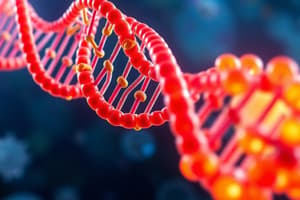Podcast
Questions and Answers
What is the main function of the plasma membrane in prokaryotic cells?
What is the main function of the plasma membrane in prokaryotic cells?
- Synthesizing proteins
- Storing genetic material
- Producing energy
- Regulating the entry and exit of substances (correct)
Where is the DNA located in a prokaryotic cell?
Where is the DNA located in a prokaryotic cell?
- In the nucleus
- In the cytoplasm (correct)
- In the ribosomes
- Attached to the plasma membrane
Which organelle in prokaryotic cells is responsible for protein synthesis?
Which organelle in prokaryotic cells is responsible for protein synthesis?
- Plasma Membrane
- Ribosomes (correct)
- Pili
- Flagella
What is the role of pili in prokaryotic cells?
What is the role of pili in prokaryotic cells?
Which component of prokaryotic cells directs the synthesis of proteins?
Which component of prokaryotic cells directs the synthesis of proteins?
What is the function of flagella in prokaryotic cells?
What is the function of flagella in prokaryotic cells?
How do plasmids differ from the chromosome in prokaryotic cells?
How do plasmids differ from the chromosome in prokaryotic cells?
What is the primary function of prokaryotic cells in relation to nutrient breakdown?
What is the primary function of prokaryotic cells in relation to nutrient breakdown?
How do prokaryotic cells replicate their DNA?
How do prokaryotic cells replicate their DNA?
What distinguishes the replication of DNA in prokaryotic cells from eukaryotic cells?
What distinguishes the replication of DNA in prokaryotic cells from eukaryotic cells?
What is the role of Metabolic Control of Replication (MCR) in prokaryotic cells?
What is the role of Metabolic Control of Replication (MCR) in prokaryotic cells?
Which process allows prokaryotic cells to rapidly grow their population?
Which process allows prokaryotic cells to rapidly grow their population?
Study Notes
Prokaryotic cells, also known as prokaryotes, are single-celled organisms that lack a nucleus and other membrane-bound organelles. They belong to the domains Bacteria and Archaea, and they are found everywhere on Earth, from the deep sea to the human gut. Prokaryotic cells are responsible for various vital functions, including nutrient breakdown, energy production, and DNA replication.
Structure of Prokaryotic Cells
Prokaryotic cells are composed of four main components:
- Plasma Membrane: This is the outer protective covering of phospholipids that separates the cell from the environment. It regulates the entry and exit of substances in the cell.
- Cytoplasm: This is a gel-like substance present inside the cell. All the cell organelles, enzymes, and dissolved ions are suspended in it.
- DNA: Prokaryotic cells possess a circular DNA chromosome that directs the synthesis of proteins and regulates cellular activities.
- Ribosomes: These are protein-building factories where protein synthesis occurs.
Prokaryotic cells may also have additional structures like pili, flagella, and plasmids, which serve various functions:
- Pili: These are hair-like outgrowths that help prokaryotic cells attach to surfaces and exchange genetic material with other cells.
- Flagella: These are long structures in the form of a whip that help prokaryotic cells move.
- Plasmids: These are non-chromosomal DNA structures that carry a small number of non-essential genes and are copied independently of the chromosome inside the cell.
Function of Prokaryotic Cells
Prokaryotic cells have various functions, including:
- Nutrient Breakdown: Prokaryotes play a crucial role in breaking down organic matter, releasing nutrients and energy for other organisms.
- Energy Production: Prokaryotes produce ATP, the energy currency of cells, through processes like respiration and photosynthesis.
- DNA Replication: Prokaryotic cells replicate their DNA through a process called binary fission, which involves the duplication and separation of the circular chromosome.
- Metabolism: Prokaryotic cells carry out metabolic processes, converting nutrients into energy and building blocks for growth and reproduction.
DNA Replication in Prokaryotic Cells
Prokaryotic cells replicate their DNA through a process called binary fission. This process is less complicated and much quicker than cell division in eukaryotes, allowing for rapid population growth. The replication of the DNA is bidirectional, occurring simultaneously on both strands of the DNA loop, and is initiated at a specific location, the origin, near the binding site of the chromosome to the plasma membrane.
Metabolism in Prokaryotic Cells
Prokaryotic cells rely on metabolic processes to produce energy and precursors for DNA replication. These metabolic processes involve the catabolic branch, which breaks down nutrients, and the anabolic branch, which consumes energy and precursors for DNA replication. The metabolic control of replication (MCR) coordinates these processes to ensure that DNA replication occurs only once per cell cycle and that the replication machinery receives the necessary energy and precursors.
In conclusion, prokaryotic cells are vital to life on Earth, playing essential roles in various ecological processes and contributing significantly to our understanding of fundamental biological functions. Their unique structures and processes, such as binary fission and MCR, have provided valuable insights into cellular biology and evolution.
Studying That Suits You
Use AI to generate personalized quizzes and flashcards to suit your learning preferences.
Description
Explore the characteristics, components, and functions of prokaryotic cells, including their structure, DNA replication process, and vital roles in nutrient breakdown and energy production. Learn about the unique features like pili, flagella, MCR, and binary fission.




